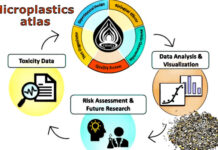Mediterranean. A sea of plastics and microplastics. The situation is ‘alarming,’ according to the report presented by ISPRA on 9.10.19. Brief reflections on this.
ISPRA, monitoring report on the marine environment in Italy.
The Istituto Superiore per la Protezione e la Ricerca Ambientale (ISPRA) published, on 9.10.19, its annual report on marine litter on Italian coasts and seabeds. (1) As part of the monitoring program established under the so-called European ‘Marine Strategy’. (2). And its title is eloquent, ‘With Waste We’ve Hit Bottom‘.
‘More than 70 percent of marine litter is deposited in the Italian seabed and 75 percent is plastic.’
Analyses conducted by Ispra-with input from the System for the Protection of the Environment (SNPA)-show that the Mediterranean is one of the seas most plagued by plastic pollution. Receiving as much as 7 percent of the total plastic poured into the planet’s seas (8 million tons).
Mediterranean, a sea of dumps
Offshore dumps characterize our seas, according to ISPRA surveys. 786 objects totaling 0.7 ton per km2 on sandy seabed in Sicily, 403 objects in Sardinia (for 86.55 kg of waste). With peaks on rocky bottoms from 20 to 500 meters deep. 1500 items in the Ligurian Sea, the 1200 in the Gulf of Naples, and the 900 along the Sicilian coast. In the Adriatic and Ionian Seas, however, the most polluted areas are south of the Po Delta (983 wastes per km2), Corfu (>800) and Dubrovnik (559) on the eastern front. The overall Adriatic-Ionian average exceeds 300 wastes per km2, of which 86 percent is in plastics, mostly single-use items.
The waste partly comes from the land and is dragged to the sea through rivers. Monitoring conducted by Ispra as part of the MedSeaLitter 2017-2018 project shows that river estuaries have the highest concentration of floating litter, more than 1,000 objects per km2. Which also abound in the seas near the coasts, between 10 and 600 units per square kilometer. To then degrade (or sink) in the open sea, where floating waste units drop to 1-10. Industrial and food packaging, plastic bags, shoppers and bottles, and mussel nets are the most common items.
Surface pollution is also of concern. Not only for macroplastics, whose average density varies between 2 and 5 units per square kilometer. But mostly because of the density of microplastics-microparticles measuring less than 5 mm-which varies between 93-204 thousand in the same area. On the beaches, for that matter, 500 to 1,000 pieces of garbage were detected every center meter.
Plastic pollution, what solutions?
Packaging of food and other consumer items is one of the leading causes of plastic and microplastic pollution in the seas. The EuropeanSingle Use Plastics Directive ( SUPs ) has banned the use of some single-use plastic items, but has overlooked some of the key players in the current disaster. One over all, disposable cups. The so-called ‘Circular Economy Package,’ in turn, is undoubtedly a big step forward in the overall life cycle management of the generality of products. But it is not enough.
Thecircular economy remains the path to follow, following in the wake of Lansink’s scale. They continue to elude, however, the attention of policymakers and operators in the relevant supply chains:
– the essential value of education so that the waste hierarchy can find concrete implementation in everyone’s daily life,
– the urgency of affirming the extended responsibility of producers, with regard to the entire life cycle of their goods and their packaging. This is the only way to achieve a real transformation of consumption patterns, which must be oriented where possible toward overcoming ‘disposable’. In the direction of reduction and reuse, which have quite different value from recycling,
– The need to consider other causes of plastic and microplastic pollution. And to assert ‘extended producer’s responsibility’ in other areas as well. One should look not only at textiles and apparel or other FMCG(Fast Moving Consumers Goods) but also at manufacturing activities. Such as agriculture, where mulch sheeting and other plastic materials, to name a few examples, tend to be dispersed into the ecosystem beyond control.
Dario Dongo and Sabrina Bergamini
Notes
(1) Ispra (2019). With waste, we’ve hit rock bottom and 75% is plastic http://www.isprambiente.gov.it/it/ispra-informa/area-stampa/comunicati-stampa/anno-2019/con-i-rifiuti-abbiamo-toccato-il-fondo-e-il-75-e-plastica
(2) See dir. 2008/56/EC, marine strategy framework directive.









